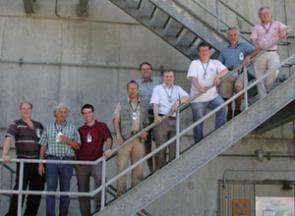A Positive Spin

Beams with polarized particles greatly boost the physics output of high energy physics colliders. While it has been straightforward to make polarized electron beams, polarizing positrons is more difficult, especially in the case of linear colliders. The E-166 experiment has successfully demonstrated a technology to make a polarized beam of positrons for a future linear collider.
For decades, Stanford Linear Accelerator Center (SLAC) has been making positrons—the antimatter equivalent of electrons—but this is the first polarized positron beam at SLAC. Polarized means the particles are oriented to spin in the same direction; imagine most of the golf balls at a driving range rotating clockwise as they fly toward the net. Beams never reach 100 percent polarization, but the more polarized the beams, the more information they reveal in collisions.
E-166 proves that the proposed International Linear Collider (ILC) could be designed with a polarized positron beam. The collaboration is still analyzing the results to determine the precise amount of polarization achieved. “Let’s say the beam is definitely polarized, sufficient for a linear collider,” said Bill Bugg (University of Tennessee, Knoxville).
In two runs during June and September 2005, the collaboration used SLAC’s two-mile linac to deliver electrons to the Final Focus Test Beam (FFTB). There the electrons travel through a helical undulator, a one-meter-long magnet that forces the electrons to spiral, thus emitting polarized gamma rays. The gamma rays strike a tungsten target, producing showers of polarized positrons with an average energy of 5 to 6 million electron volts (MeV). Alexander Mikhailichenko (Cornell), who built the undulator for the experiment, was one of the people to originally propose the technique in 1979.
The electrons travel through the undulator in a tiny beam pipe—a stainless steel tube with a 0.9-millimeter inside diameter. The pipe is cut from the same hollow metal used for hypodermic needles and cheap, too, at $1 per foot. Even though the electron beam is 20 times narrower than the pipe aperture, some feared the small pipe would be a showstopper. The beam needed to go cleanly through the undulator without touching the pipe wall. Any beam loss at all would have saturated the detectors with background noise.
“The undulator performance was superb, like flipping a switch,” said experiment spokesman John Sheppard (ILC).
The results put to rest doubts that helical undulators would produce circularly polarized gamma rays or that polarized gamma rays would in turn produce polarized positrons.
“SLAC was the only place we could possibly do this experiment,” Sheppard said. “We needed a 50 GeV low-emittance (transversely small) beam, small enough to fit through the undulator beam pipe. The success of the experiment in large part was due to the excellent beam quality and stability delivered by the SLAC operations staff.”
Collaborators who took shifts at SLAC came from the University of Tennessee, DESY Hamburg, DESY Zeuthen, Humboldt University Berlin, Cornell, Daresbury, RWTH Aachen, Princeton and Tel-Aviv University.
Source: Stanford Linear Accelerator Center (Heather Rock Woods)



















